Page 606 of 636
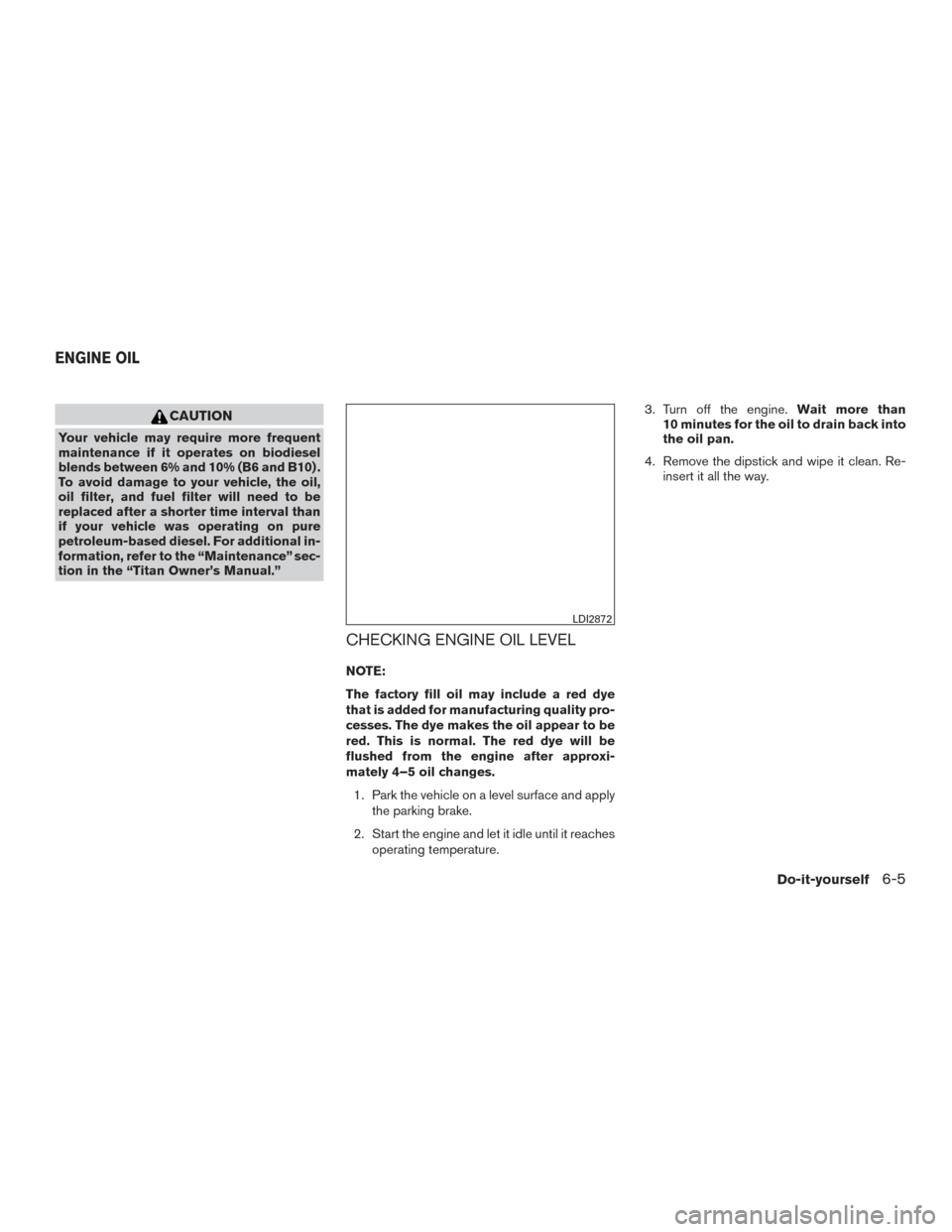
CAUTION
Your vehicle may require more frequent
maintenance if it operates on biodiesel
blends between 6% and 10% (B6 and B10) .
To avoid damage to your vehicle, the oil,
oil filter, and fuel filter will need to be
replaced after a shorter time interval than
if your vehicle was operating on pure
petroleum-based diesel. For additional in-
formation, refer to the “Maintenance” sec-
tion in the “Titan Owner’s Manual.”
CHECKING ENGINE OIL LEVEL
NOTE:
The factory fill oil may include a red dye
that is added for manufacturing quality pro-
cesses. The dye makes the oil appear to be
red. This is normal. The red dye will be
flushed from the engine after approxi-
mately 4–5 oil changes.1. Park the vehicle on a level surface and apply the parking brake.
2. Start the engine and let it idle until it reaches operating temperature. 3. Turn off the engine.
Wait more than
10 minutes for the oil to drain back into
the oil pan.
4. Remove the dipstick and wipe it clean. Re- insert it all the way.
LDI2872
ENGINE OIL
Do-it-yourself6-5
Page 607 of 636
5. Remove the dipstick again and check the oillevel. It should be between the high and low
marks
�B. This is the normal operating oil
level range. If the oil level is below the low
mark
�A, remove the oil filler cap and pour
recommended oil through the opening. Do
not overfill
�C.
6. Recheck oil level with the dipstick.
It is normal to add some oil between oil
maintenance intervals or during the
break-in period, depending on the severity
of operating conditions.
CAUTION
Oil level should be checked regularly. Op-
erating the engine with an insufficient
amount of oil can damage the engine, and
such damage is not covered by warranty.
CHANGING ENGINE OIL
LDI2873
LDI2874
6-6Do-it-yourself
Page 610 of 636
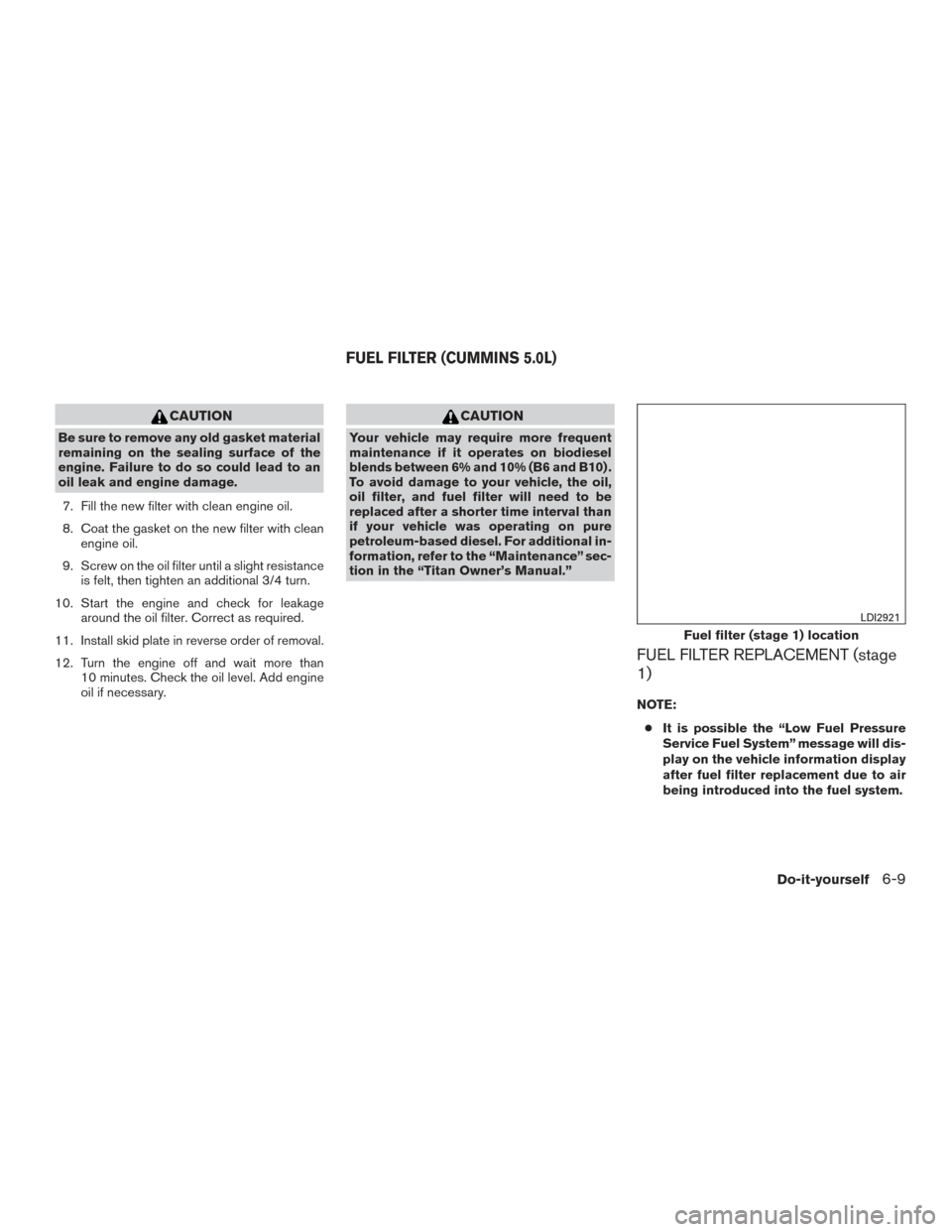
CAUTION
Be sure to remove any old gasket material
remaining on the sealing surface of the
engine. Failure to do so could lead to an
oil leak and engine damage.7. Fill the new filter with clean engine oil.
8. Coat the gasket on the new filter with clean engine oil.
9. Screw on the oil filter until a slight resistance is felt, then tighten an additional 3/4 turn.
10. Start the engine and check for leakage around the oil filter. Correct as required.
11. Install skid plate in reverse order of removal.
12. Turn the engine off and wait more than 10 minutes. Check the oil level. Add engine
oil if necessary.
CAUTION
Your vehicle may require more frequent
maintenance if it operates on biodiesel
blends between 6% and 10% (B6 and B10) .
To avoid damage to your vehicle, the oil,
oil filter, and fuel filter will need to be
replaced after a shorter time interval than
if your vehicle was operating on pure
petroleum-based diesel. For additional in-
formation, refer to the “Maintenance” sec-
tion in the “Titan Owner’s Manual.”
FUEL FILTER REPLACEMENT (stage
1)
NOTE:
● It is possible the “Low Fuel Pressure
Service Fuel System” message will dis-
play on the vehicle information display
after fuel filter replacement due to air
being introduced into the fuel system.
Fuel filter (stage 1) location
LDI2921
FUEL FILTER (CUMMINS 5.0L)
Do-it-yourself6-9
Page 619 of 636
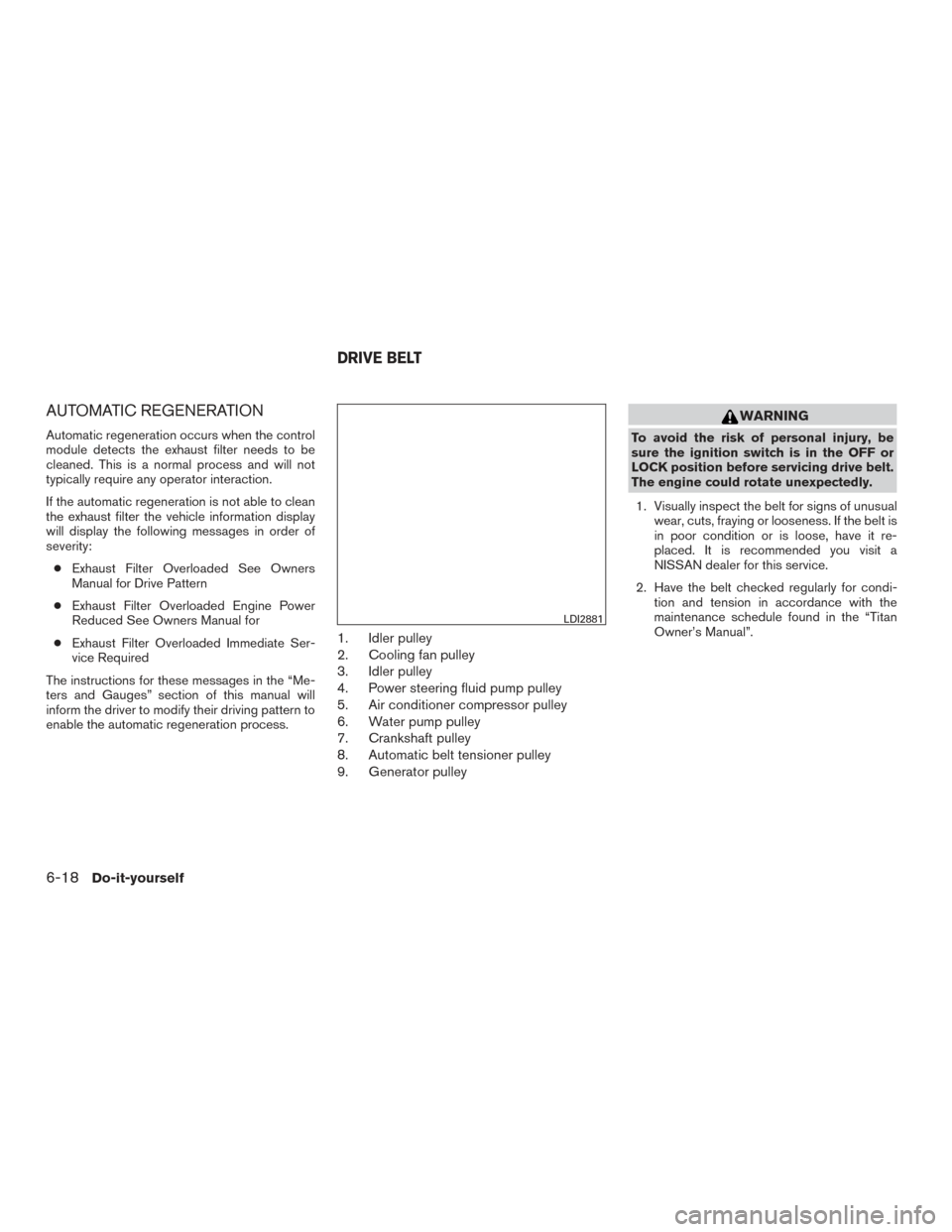
AUTOMATIC REGENERATION
Automatic regeneration occurs when the control
module detects the exhaust filter needs to be
cleaned. This is a normal process and will not
typically require any operator interaction.
If the automatic regeneration is not able to clean
the exhaust filter the vehicle information display
will display the following messages in order of
severity:● Exhaust Filter Overloaded See Owners
Manual for Drive Pattern
● Exhaust Filter Overloaded Engine Power
Reduced See Owners Manual for
● Exhaust Filter Overloaded Immediate Ser-
vice Required
The instructions for these messages in the “Me-
ters and Gauges” section of this manual will
inform the driver to modify their driving pattern to
enable the automatic regeneration process.
1. Idler pulley
2. Cooling fan pulley
3. Idler pulley
4. Power steering fluid pump pulley
5. Air conditioner compressor pulley
6. Water pump pulley
7. Crankshaft pulley
8. Automatic belt tensioner pulley
9. Generator pulley
WARNING
To avoid the risk of personal injury, be
sure the ignition switch is in the OFF or
LOCK position before servicing drive belt.
The engine could rotate unexpectedly.
1. Visually inspect the belt for signs of unusual wear, cuts, fraying or looseness. If the belt is
in poor condition or is loose, have it re-
placed. It is recommended you visit a
NISSAN dealer for this service.
2. Have the belt checked regularly for condi- tion and tension in accordance with the
maintenance schedule found in the “Titan
Owner’s Manual”.
LDI2881
DRIVE BELT
6-18Do-it-yourself
Page 620 of 636
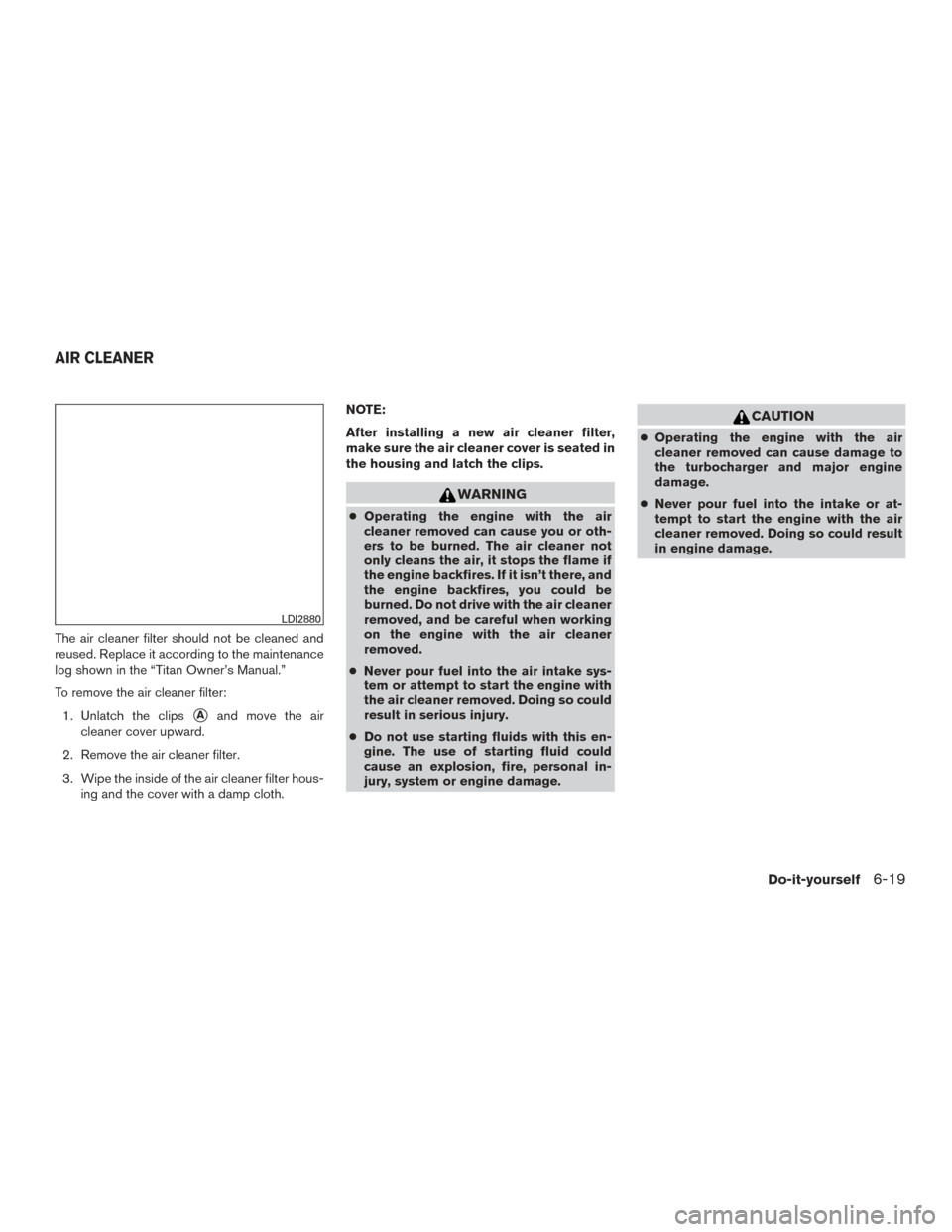
The air cleaner filter should not be cleaned and
reused. Replace it according to the maintenance
log shown in the “Titan Owner’s Manual.”
To remove the air cleaner filter:1. Unlatch the clips
�Aand move the air
cleaner cover upward.
2. Remove the air cleaner filter.
3. Wipe the inside of the air cleaner filter hous- ing and the cover with a damp cloth. NOTE:
After installing a new air cleaner filter,
make sure the air cleaner cover is seated in
the housing and latch the clips.
WARNING
●
Operating the engine with the air
cleaner removed can cause you or oth-
ers to be burned. The air cleaner not
only cleans the air, it stops the flame if
the engine backfires. If it isn’t there, and
the engine backfires, you could be
burned. Do not drive with the air cleaner
removed, and be careful when working
on the engine with the air cleaner
removed.
● Never pour fuel into the air intake sys-
tem or attempt to start the engine with
the air cleaner removed. Doing so could
result in serious injury.
● Do not use starting fluids with this en-
gine. The use of starting fluid could
cause an explosion, fire, personal in-
jury, system or engine damage.
CAUTION
● Operating the engine with the air
cleaner removed can cause damage to
the turbocharger and major engine
damage.
● Never pour fuel into the intake or at-
tempt to start the engine with the air
cleaner removed. Doing so could result
in engine damage.
LDI2880
AIR CLEANER
Do-it-yourself6-19
Page 626 of 636
8 Capacities and Specifications
Recommended fluids/lubricants and capacities.......8-2
Fuel recommendation ...........................8-3
Engine oil and oil filter recommendations ..........8-5
Specifications .....................................8-7 Engine
........................................8-7
Readiness for inspection/maintenance (I/M) test
(diesel engine only) ................................8-8
Page 627 of 636
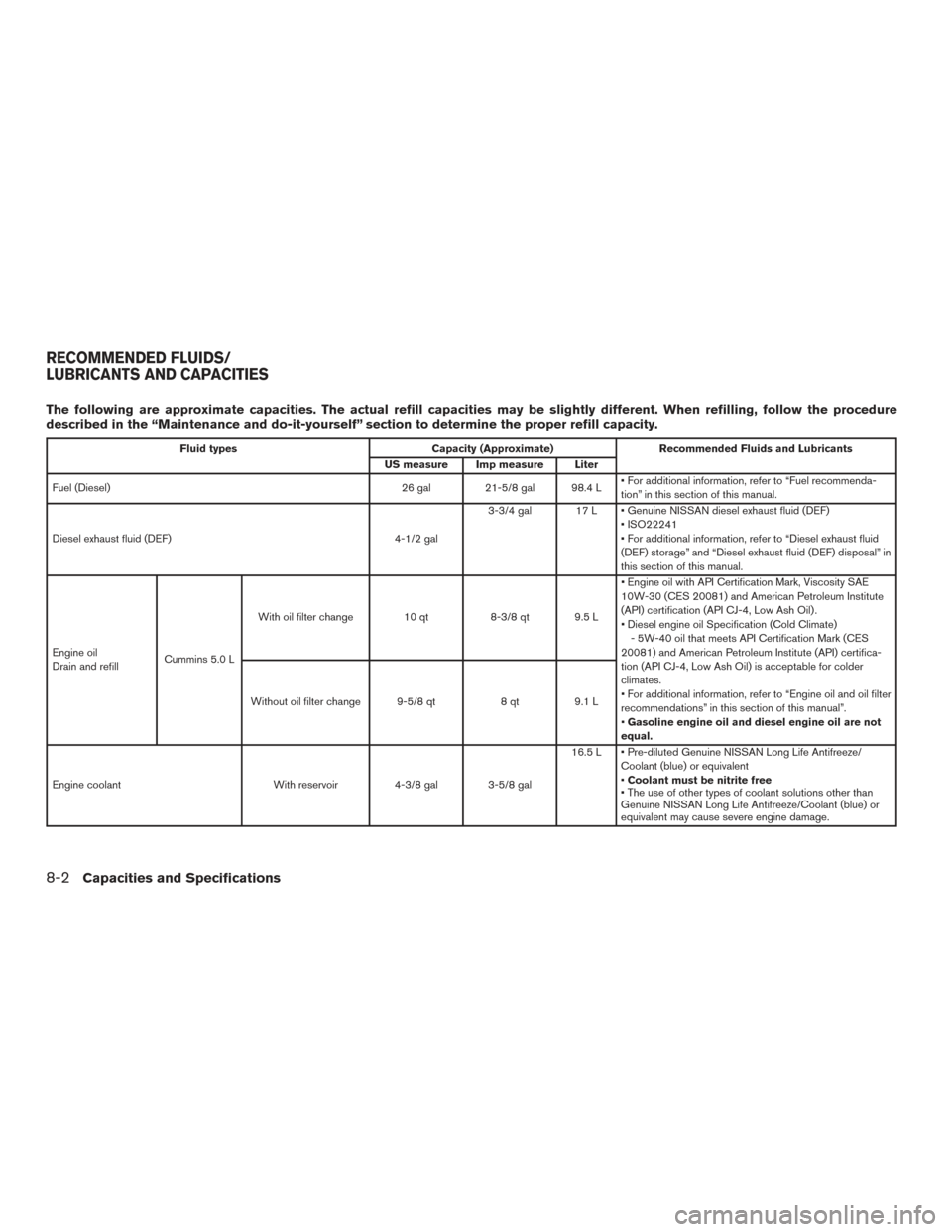
The following are approximate capacities. The actual refill capacities may be slightly different. When refilling, follow the procedure
described in the “Maintenance and do-it-yourself” section to determine the proper refill capacity.
Fluid typesCapacity (Approximate)Recommended Fluids and Lubricants
US measure Imp measure Liter
Fuel (Diesel) 26 gal 21-5/8 gal 98.4 L• For additional information, refer to “Fuel recommenda-
tion” in this section of this manual.
Diesel exhaust fluid (DEF) 4-1/2 gal3-3/4 gal 17 L • Genuine NISSAN diesel exhaust fluid (DEF)
• ISO22241
• For additional information, refer to “Diesel exhaust fluid
(DEF) storage” and “Diesel exhaust fluid (DEF) disposal” in
this section of this manual.
Engine oil
Drain and refill Cummins 5.0 LWith oil filter change 10 qt
8-3/8 qt 9.5 L• Engine oil with API Certification Mark, Viscosity SAE
10W-30 (CES 20081) and American Petroleum Institute
(API) certification (API CJ-4, Low Ash Oil) .
• Diesel engine oil Specification (Cold Climate)
- 5W-40 oil that meets API Certification Mark (CES
20081) and American Petroleum Institute (API) certifica-
tion (API CJ-4, Low Ash Oil) is acceptable for colder
climates.
• For additional information, refer to “Engine oil and oil filter
recommendations” in this section of this manual”.
• Gasoline engine oil and diesel engine oil are not
equal.
Without oil filter change 9-5/8 qt
8 qt9.1 L
Engine coolant With reservoir4-3/8 gal 3-5/8 gal 16.5 L • Pre-diluted Genuine NISSAN Long Life Antifreeze/
Coolant (blue) or equivalent
•Coolant must be nitrite free
• The use of other types of coolant solutions other than
Genuine NISSAN Long Life Antifreeze/Coolant (blue) or
equivalent may cause severe engine damage.
RECOMMENDED FLUIDS/
LUBRICANTS AND CAPACITIES
8-2Capacities and Specifications
Page 631 of 636
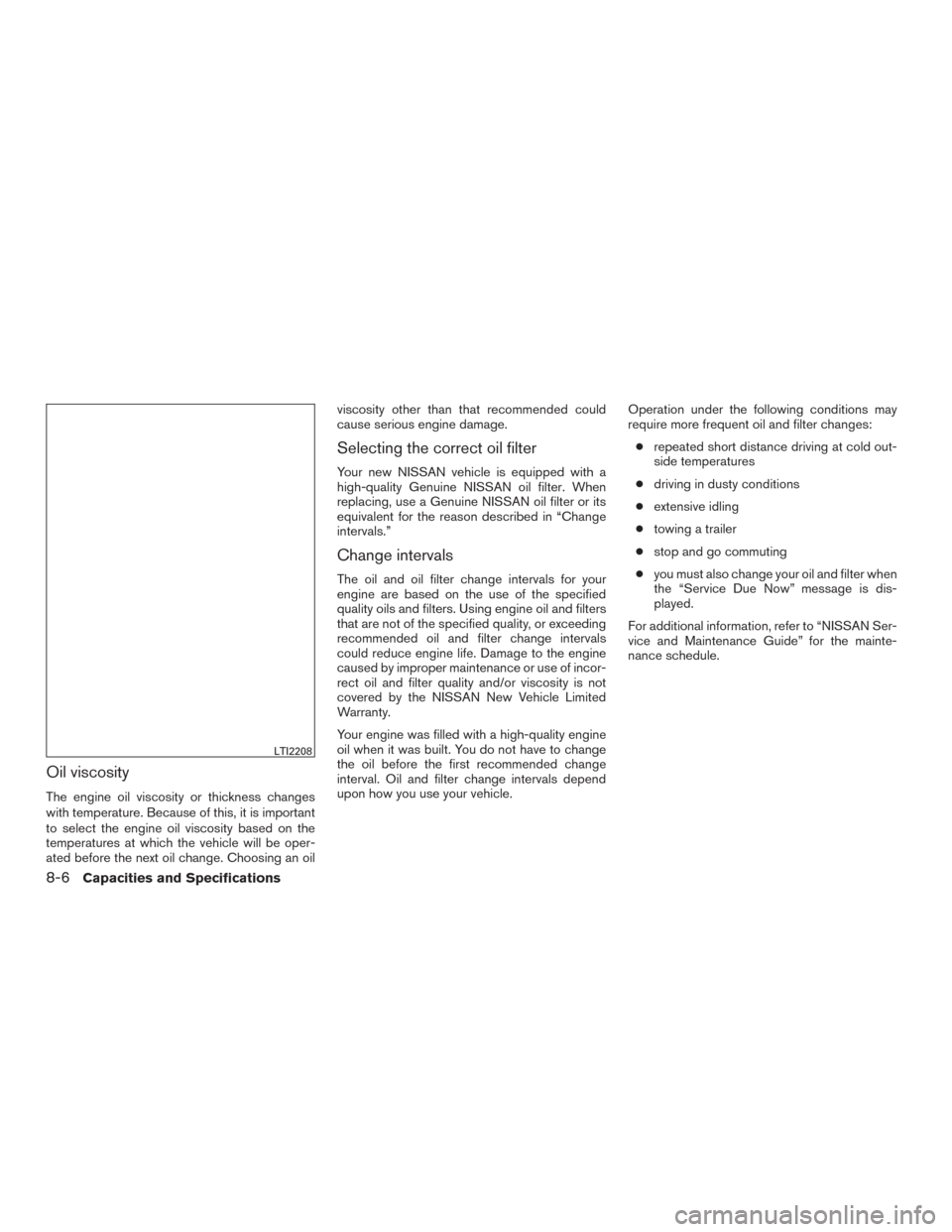
Oil viscosity
The engine oil viscosity or thickness changes
with temperature. Because of this, it is important
to select the engine oil viscosity based on the
temperatures at which the vehicle will be oper-
ated before the next oil change. Choosing an oilviscosity other than that recommended could
cause serious engine damage.
Selecting the correct oil filter
Your new NISSAN vehicle is equipped with a
high-quality Genuine NISSAN oil filter. When
replacing, use a Genuine NISSAN oil filter or its
equivalent for the reason described in “Change
intervals.”
Change intervals
The oil and oil filter change intervals for your
engine are based on the use of the specified
quality oils and filters. Using engine oil and filters
that are not of the specified quality, or exceeding
recommended oil and filter change intervals
could reduce engine life. Damage to the engine
caused by improper maintenance or use of incor-
rect oil and filter quality and/or viscosity is not
covered by the NISSAN New Vehicle Limited
Warranty.
Your engine was filled with a high-quality engine
oil when it was built. You do not have to change
the oil before the first recommended change
interval. Oil and filter change intervals depend
upon how you use your vehicle.
Operation under the following conditions may
require more frequent oil and filter changes:
● repeated short distance driving at cold out-
side temperatures
● driving in dusty conditions
● extensive idling
● towing a trailer
● stop and go commuting
● you must also change your oil and filter when
the “Service Due Now” message is dis-
played.
For additional information, refer to “NISSAN Ser-
vice and Maintenance Guide” for the mainte-
nance schedule.
LTI2208
8-6Capacities and Specifications